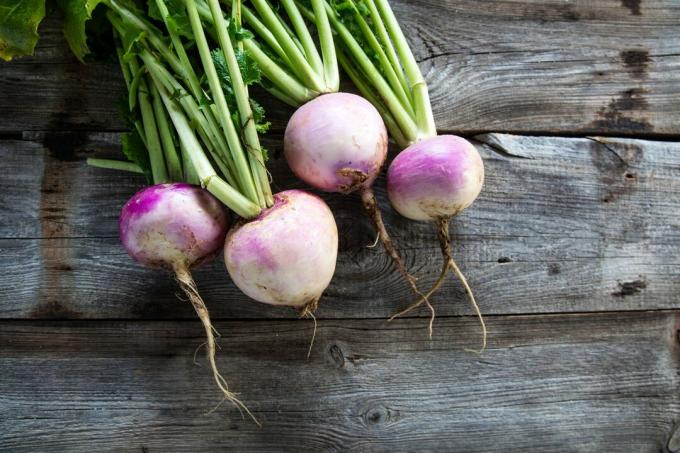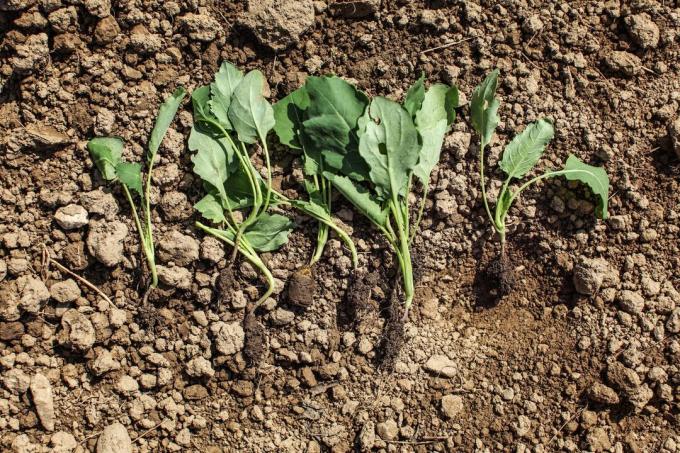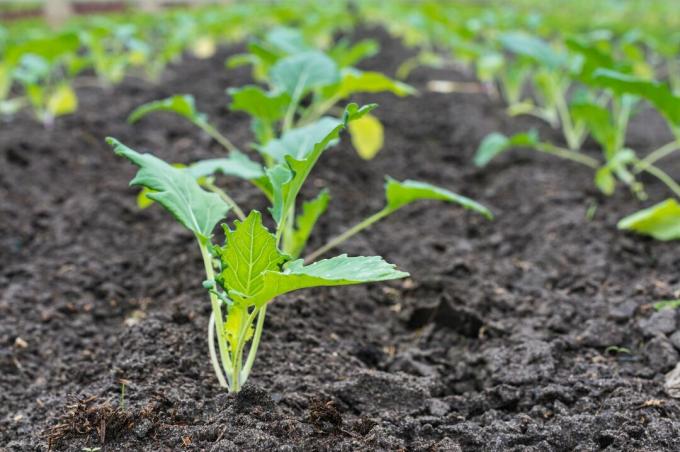Depending on the time of sowing, the May turnip can become an autumn turnip. We show what you have to consider when growing, caring for and harvesting May and autumn turnips.

turnips (Brassica rapa subsp. rapa var. majalis) and autumn turnips (Brassica rapa subsp. rapa subvar. esculenta) are very similar in cultivation. Only their planting and harvesting times differ from each other. Growing turnips in your own garden is always worthwhile: They are easy to care for, grow quickly and are full of vitamins and minerals. We'll tell you everything you need to know about the origin, the right choice of variety, cultivation, care and harvesting of May and autumn turnips.
contents
- May turnip: origin and properties
- May turnip and autumn turnip varieties
- Buy May turnips: you should pay attention to that
- Grow May turnip and Fall turnip
- Caring for turnips
- Harvest and store turnips
- Turnips: use and ingredients
The different botanical names of May and autumn turnips already indicate that the two are not one and the same plant. In fact, both are special forms of turnip (Brassica rapa subsp. rapa). The two names indicate when the turnips were harvested: May turnips are grown in spring and harvested in May – autumn turnips, on the other hand, only later in the year. Both belong to the cruciferous family (Brassicaceae). Both look similar radish (Raphanus sativus var. sativus), but are a bit larger.
Both May and autumn turnips have an unbelievable variety of varieties and differ mainly in their shape and colour. In Switzerland there is an old custom that is reminiscent of Halloween pumpkins. Instead of pumpkin (Cucurbita) autumn turnips are hollowed out and carved there. The so-called "Räbenlichter" light up the dark autumn nights. In Austria, even a schnapps is made from autumn turnips, the so-called Krautinger. The turnips have also been popular for centuries because they are characterized by their easy-care nature and are quite insensitive to frost.

May turnip: origin and properties
May and autumn turnips have been cultivated since ancient times. Before the introduction of potato (solanumtuberosum), they played an important role as the main food of the people in Europe. But once the potato was on the menu, the turnips were almost completely pushed off the plate. In the post-war period, they were then increasingly cultivated again, both as root crops and as fodder plants. After the hardship was over, however, many no longer wanted to be reminded of the meager post-war years, so that May and autumn turnips were spurned and rarely ended up on the plate. Only in recent years have beets regained importance as a regional and seasonal vegetable.
May and autumn turnips are biennial plants. In the first year they form a tuber in the ground and a rosette of leaves above ground. Beets are almost always only grown once a year. If you cultivate them in the second year, autumn and May turnips form a branched inflorescence with yellow flowers. Strictly speaking, the edible beets are the thickened, lowest part of the shoot axis - the hypocotyl - and the uppermost part of the root. Depending on the variety, May and Autumn turnips produce white, purple, red or yellow turnips with white or yellow flesh.
May turnip and autumn turnip varieties
The individual varieties of May and autumn turnips differ primarily in the shape and color of the turnips. We will introduce you to some tried-and-tested varieties of the two beets.
Turnip Varieties
- ˈMunich swede turnipˈ: This variety is characterized by a flat, round shape and a delicate red head. It does not form too lush foliage.
- ˈSnowballˈ: The beets of this variety really do look like snowballs: they are round and completely white.
- ˈMilanˈ: The beets of this variety are rather flat and have a red head.
- ˈPrimeraˈ: This variety of turnips has a particularly delicate flavor reminiscent of kohlrabi. The beets are red-headed and flat.

Fall Beet Varieties
- ˈBortfelderˈ: This autumn turnip variety develops elongated, yellow-fleshed turnips. It can be stored very well.
- ˈgold ballˈ: As the name suggests, this variety is round and has yellow flesh. It is also characterized by a particularly short growth time of just two months.
- ˈUlm ox hornˈ: This variety forms elongated, slightly curved beets with a white-purple color.
- ˈZurichˈ: This variety convinces with a round beet and a violet head. It can be stored very well.
Buy May turnips: you should pay attention to that
May and fall turnips can easily be grown yourself or, even better, sowed directly in the bed. It is therefore not advisable to buy young plants that have already been grown early. When buying May or autumn turnip seeds, you should pay attention to the right variety. Depending on whether you want to grow the beets in spring or autumn, you have to use different varieties. If you decide to buy early young plants anyway, make sure the plants are healthy and vital. Seeds and young plants for May and autumn turnips can be bought in DIY stores, garden centres, nurseries or on the Internet.

Grow May turnip and Fall turnip
The main difference between the cultivation of May and autumn turnips is the time of cultivation. When it comes to care and harvest, there are no major differences. In the following section we will tell you what to pay particular attention to when growing the two beets.
Growing May turnips and autumn turnips: The perfect location
Both May and autumn turnips are weak consumers and do not place particularly high demands on their location. The turnips are quite happy in a sunny to partially shaded spot with light, humus-rich soil. Beets are less happy with waterlogging, as this is where they start to mold and rot. Too acidic soils are also unfavorable - the optimal pH value should be above 6.5.
Summary of site requirements for May turnips and autumn turnips:
- Sunny to semi-shady location
- Light, humus-rich soil
- pH above 6.5
- No waterlogging
Tip: As with all plants belonging to the cruciferous family, a cultivation break of three years should be observed after beet cultivation, otherwise diseases such as Clubroot be able to move in.

Sow and grow turnips
May turnips can also be brought forward, but they also do very well when sowed directly in the garden bed and the time from sowing to harvest is also very short. If you prefer to prepare your May turnips, you can start doing so as early as February on the warm window sill or in the heated greenhouse. Turnips begin to germinate at temperatures above 5 °C, the optimal germination temperature is between 15 and 18 °C. You can start sowing directly in the garden bed from March.
Prepare the bed for sowing outdoors by loosening the soil, removing weeds and working in compost if necessary. Alternatively, you can also work an organic slow-release fertilizer into the soil to improve soil structure and enrich the soil with nutrients. For this we recommend our Plantura organic universal fertilizer with organic long-term effect.
The turnips are sown two centimeters deep, with a row spacing of 20 to 25 centimetres. The distance between the plants should be 10 to 15 centimeters. Alternatively, you can sow the turnips broadly and then separate them later as soon as they are in the dicot stage. Then the seed is watered and kept moist. Your turnips should germinate after seven to twelve days.
Summary of sowing and growing turnips:
- Advance from February
- Sow in the garden bed from March
- Loosen the seedbed, remove weeds, compost or incorporate organic long-term fertilizers
- Optimum germination temperature: 15 – 18 °C
- Sowing depth: 2 cm
- Planting distance: 10 - 15 cm
- Row spacing: 20 – 25 cm
- Germination after 7-12 days

Tip: May turnips are good planting neighbors strawberries (Fragaria) or carrots (Daucus carota subsp. sativus). are rather unsuitable cucumbers (Cucumis sativus) and zucchini (Cucurbita pepo subsp. pepo convar. giromontiina).
Sowing and growing autumn turnips
Autumn turnips are sown and grown in a similar way to May turnips. Only the time of sowing is different: autumn turnips are sown at the beginning of August. Here, too, it is not necessary to prefer young plants. The sowing depth for autumn turnips is also two centimeters. The row spacing of autumn turnips should be slightly larger than that of May turnips: 20 to 25 centimeters should be sufficient. The distance between the plantlets is also slightly larger; it is 20 to 30 centimeters.
Summary of growing autumn turnips:
- Sow in the bed from the beginning of August
- Sowing depth: 2 cm
- Planting distance: 20 - 30 cm
- Distance between rows: 20-25 cm
Both May and autumn turnips can withstand frost down to -10 °C.
Tip: Good neighbors for autumn turnips are endives (Cichorium endivia) or Lamb's lettuce (Valerianella locusta).
Caring for turnips
May and autumn turnips are easy to grow and require little care. You should only make sure that the plants do not dry out and therefore water them regularly when they are dry. In addition, regular hoeing ensures that no weeds can spread and the soil is loosened up nicely. A finely crumbly soil surface is particularly important for beets. It promotes even growth and good formation of the beets. Since May and autumn turnips are weak consumers, additional fertilizing is not necessary. It is sufficient if you use the soil when planting compost or organic long-term fertilizer, such as our Plantura Organic universal fertilizer, have enriched.
Harvest and store turnips
Harvesting can begin six to eight weeks after sowing. When harvested, the beets should have a maximum diameter of ten centimetres. Because the smaller they are, the more delicate and refined their taste. To harvest, the beets are carefully pulled out of the ground by the leaves. If the beets are to be stored, the heart leaves must remain on the beets. If you want to eat the beets right away, the leaves are twisted off. Fresh turnips can be stored in the fridge for a good four weeks. For larger quantities of turnips, storage in the basement or in heaps is a good idea. This is of particular interest for autumn beets that are to be stored over the winter. But turnips can also be stored in this way. In the basement, the beets can be stored in a box with slightly damp sand. Autumn turnips will keep in the cellar or in the heap until next spring and provide you with fresh vitamins throughout the winter.

Turnips: use and ingredients
Turnips contain carbohydrates, protein, calcium, potassium, phosphorus, iron, sodium, provitamin A, as well as vitamins B1, B2, B6 and C - a real vitamin bomb. Depending on the variety, the beets can be flavored with Kohlrabi or mild radishes and have a strong, spicy aroma. You can use the beets fresh as raw vegetables or in salads. The turnips can also be stewed, steamed or made into stews.
If you haven't had enough of turnips, you'll find everything here Cultivation and care of turnips.
